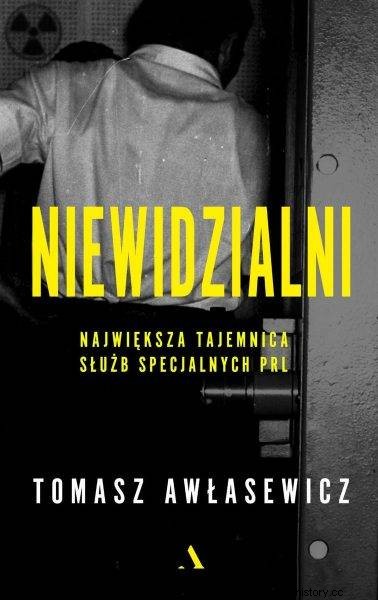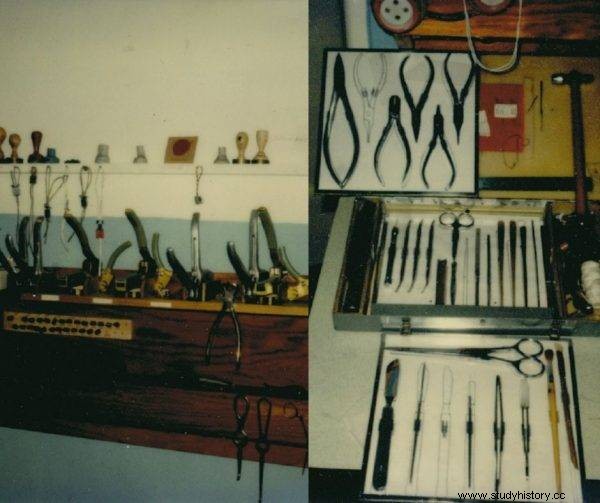During the Polish People's Republic, a special counterintelligence group operated in the Ministry of the Interior, whose members entered embassies and consulates to search vaults under cover of night. Although hundreds of thousands of pages of classified documents were leaked by the group, no one found its trail. Those who knew about Division IX - and there were a handful of them - called them "doomed." Why? Because they used gamma rays to open vault doors and safes.
Andrzej Brzezicki:The work of Division IX you described was one of the greatest secrets of the special services of the Polish People's Republic - how did you find its trace?
Tomasz Awłasewicz , author of the book “Invisible. The greatest secret of the special services of the Polish People's Republic ”(Agora 2021):Ten years ago I watched a TV program in which the former head of the Foreign Intelligence Agency Zbigniew Siemiątkowski briefly mentioned the existence of a special counterintelligence group that uses radiation to open locks in Western embassies and consulates. The information did not arouse a sensation in the society, because it was simply hard to believe.
At that time, I also put this story between fairy tales. But a few years later, while conducting interviews with former PRL counterintelligence officers, I realized that the then services had access to a huge number of top secret documents - including those that were evidently prepared at the CIA headquarters. And so, by sticking scraps of information from the interviews, I managed to reach the former employee of Division IX.
The officers from the IX Division of the II Department spoke many languages, knew about photography, and had locksmith skills. Who and from where were recruited into Division IX?
Employees were most often sought among those who were already employed in the special services. People who had numerous secret entrances, for example to apartments, were most often chosen. Knowledge was also crucial. The best officers of the surgical technique division, engineers, sometimes graduates of the famous intelligence school in Stare Kiejkuty, IT specialists, scientists from polytechnic schools were assigned to Department IX.
Women too?
Yes. For example, a woman was responsible for the department's photo laboratory for many years. She worked stationary, i.e. she did not participate in actions, but her role was extremely important. One of the employees of Department IX, also a photographer and, consequently, her ward, told me that the officer in question was a generation older, very experienced, working in the group for many, many years. Division IX activities were top secret and frequent replacement of staff would be harmful to the conspiracy.
The security apparatus of the People's Republic of Poland does not have a good opinion - for understandable reasons. Rather, it is associated with repressions against Poles. Meanwhile, the heroes of your book seem to be professionals devoted to their work.
The repression in those days, very often against good people, is unfortunately an undeniable fact. But those responsible for them worked in other divisions. In the 1980s, Department II was actually in a different service, because at that time the Security Service and the Intelligence and Counterintelligence Service were already functioning separately.
Yes, immediately after the war, PRL counterintelligence also committed scandalous actions but in the 70s and 80s it is completely different. At that time, the "spy hunters" of the Military Internal Service, or military counterintelligence, continued to devote their time to investigating the opposition, and even people who simply spread jokes about the First Secretary of the Central Committee. On the other hand, Department II of the Ministry of the Interior, which the book is about, did not deal with such things.

Tomasz Awłasewicz writes about the mysterious Department IX in his book “Invisible. The greatest secret of the special services of the People's Republic of Poland ”, which has just been released by the Agora publishing house.
In the embassies of Western countries there could be materials that could harm the Polish democratic opposition, for example people who contacted representatives of the West ...
And here it is worth paying attention to the words "contact with representatives of the West". Contact to contact is not equal - both today and then. If in 2021 you establish "contact" with a representative of a country that is our great ally, then, believe me, you may also face criminal liability. It all depends on the nature of the relationship.
Documents found by officers in various Western institutions are now in the archives of the Institute of National Remembrance. It clearly shows which of them would be of interest only to Department III dealing with the opposition, and which contained information requiring further action by counterintelligence . The former did not hit the desks of the interested SB functionaries right away - the aforementioned Department III and Department IV, dealing with the church, in the 1980s under discussion were at the end of the list of recipients of analyzes prepared on the basis of documents obtained during secret entrances.
Counterintelligence did have a huge amount of documents in its hand that could interest these divisions, and yet there was very little specific information flowing outside the Intelligence and Counterintelligence Service.
What numbers are we talking about?
Division IX carried out up to 200 searches in facilities during one year. There are also actions in hotels. For example, in 1985 the group obtained a total of 36,000 pages of documents. Almost 1,500 were classified as "important". Meanwhile, Department III received four pieces of information throughout the year, and Department IV received three pieces of information.
Apart from them, these risers only received the so-called "Daily information". They were collective analyzes sent to various divisions and politicians. Such a document generally discussed the situation, and the source of all data was carefully camouflaged, because literally a handful of people knew about the secret entrances at the Ministry of the Interior. Nota bene, it is not even certain how much or if the directors of Departments III and IV knew about them.
Searches of hotel rooms, disguised observation of diplomats and businessmen, finally entering Western embassies and consulates at night and opening locks and safes with isotopes - what surprised you the most in the story of the book's heroes?

Items necessary for the airport group officers:on the left you can see, among others, seals standing on shelves, seals hung on nails and sealers standing on the counter. On the right, a set called by officers "knopka", containing, inter alia, scalpels and forceps.
Above the entrance to the treasury at the US consulate in Krakow, CIA officers installed a device that counts the number of door openings, just in case. Division IX forged this numerator, so that during the search it was always possible to replace it with one with a lower reading.
One time during my conversation with the former members of the group it turned out that they remember the serial number of this device. Some time later, during a visit to the Institute of National Remembrance, I found a photo of the meter. I looked at the serial number and it was exactly as my interlocutors said. The knowledge of such a detail after several decades gives an idea of how often the officers visited this place. And that's what surprised me the most - the frequency of entries, the aforementioned number of documents obtained.
How did you get the crazy idea to open locks with radiation?
As far as the laws of physics are concerned, the possibility of x-raying metal, even for laymen, was obvious.
The Americans knew that such a method was possible, but assumed that no one would be crazy enough to use it - and yet "a Pole can"?
Western security experts knew that in order to x-ray a vault door or a huge safe at an embassy, it would take a very powerful isotope - one that could be extremely dangerous when used in the confined spaces of the facility. So that's right, no one in the West thought that someone would bring such a powerful source of radiation into the embassy at night.
The doors that American special services installed at the entrances to their vaults at US consulates in Poland had a certificate which guaranteed that they would need a minimum of 20 hours to be screened. Meanwhile, the isotopes used in Department IX made it possible to obtain the image of the lock even in an hour and a half.
The issue of isotopes, however, is probably quite sensitive - after all, probably all the officers who had contact with them fell ill with cancer, and yet your interlocutors have no regrets against anyone. How do you explain that?
They are people who are very knowledgeable. They were well aware of what they were dealing with and decided to do so because it was an extremely important action. Nobody forced them to do this work. When it comes to participating in covert searches, you can't even apply the "order is order" principle .
If someone was afraid of this radiation, or the stress associated with entering a foreign facility, he could give up and no one was against him. It was a difficult job and the management realized it. Besides, the participation of a stressed officer in such risky activities was inadvisable.
The leaders of the Polish People's Republic probably had no idea how the information provided by the services is obtained?
If the First Secretary of the Central Committee of the PZPR asked how all these data were obtained, he probably got the answer. But he shouldn't have asked that. As for the rest of the politicians, it is very doubtful that they knew about the secret entrances. The information reached them in the form of collective analyzes from the Ministry of the Interior, and they would most likely be very surprised if they found out that it was actually obtained by counterintelligence, and in this way.
The book covers the topic of Hungarian spies who, during a similar operation, entered one of the western posts in Budapest and… never left. Apparently they were literally burned. Is this, according to you, a myth or a truth?
General Andrzej Kapkowski, who in the 1980s held the high position of the head of the department in the II Department, confirmed that such information was received. So you know the men came in and never came home again. Where are they? Embassies often had furnaces that allowed for very high-temperature combustion.

Tomasz Awłasewicz writes about the mysterious Department IX in his book “Invisible. The greatest secret of the special services of the People's Republic of Poland ”, which has just been released by the Agora publishing house.
Your interlocutors from time to time mention comrades from Moscow - what was the relationship of Division IX with the Soviet services?
It was they who showed the Polish services how to work with isotopes in such specific conditions. They provided help when asked, but Division IX strove for independence. The Poles carried out most of the actions without any participation of the Russians. Most of the devices for working with isotopes were also constructed by Poles, although the KGB would probably have provided them if Department II asked for it.
Your interlocutors, apart from General Andrzej Kapkowski, appear under pseudonyms and the book shows that after 1989 they also worked in the services. A specialist has no views?
It has, very precise. Only that for a good officer they are related not to the political system and not to the ruling party, but to the place of birth - his own, mother, father, grandfather and great-grandfather.
You can learn more about the mysterious IX Department in Tomasz Awłasewicz's book “Invisible. The greatest secret of the special services of the People's Republic of Poland ”, which has just been released by the Agora publishing house.
